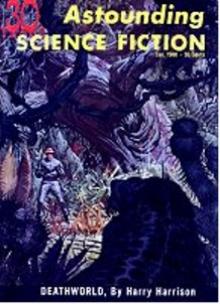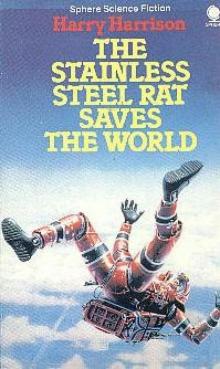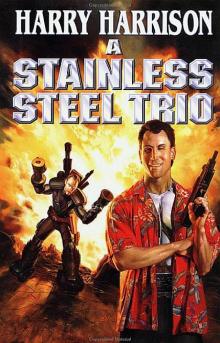- Home
- Harry Harrison
The K-Factor Page 2
The K-Factor Read online
Page 2
but as each one is consumed his worry grows greater. What willhappen when the last one is gone? Will the tiger then turn and eat him?
"Well--we are the UN's tiger. Societics came along just at the time itwas sorely needed. Earth had settled a number of planets, and governedthem. First as outposts, then as colonies. The most advanced planetsvery quickly outgrew the colony stage and flexed their independentmuscles. The UN had no particular desire to rule an empire, but at thesame time they had to insure Earth's safety. I imagine they wereconsidering all sorts of schemes--including outright militarycontrol--when they came to me.
"Even in its early, crude form, Societics provided a stopgap that wouldgive them some breathing time. They saw to it that my work was wellendowed and aided me--unofficially of course--in setting up the firstcontrol experiments on different planets. We had results, some verygood, and the others not so bad that the local police couldn't getthings back under control after a while. I was, of course, happy toperfect my theories in practice. After a hundred years I had all therough spots evened down and we were in business. The UN has never comeup with a workable alternative plan, so they have settled down to theuncomfortable business of holding the tiger's tail. They worry and spendvast sums of money keeping an eye on our work."
"But _why_?" Neel broke in.
"Why?" Abravanel gave a quick smile. "Thank you for fine characterrating. I imagine it is inconceivable to you that I might want to beEmperor of the Universe. I could be, you know. The same forces that holdthe lids on the planets could just as easily blow them off."
Neel was speechless at the awful enormity of the thought. Abravanel rosefrom behind his desk with an effort, and shambled over to lay a thin andfeather-light arm on the younger man's shoulders. "Those are the factsof life my boy. And since we cannot escape them, we must live with them.Costa is just a man doing his duty. So try and put up with him. For mysake if not for your own."
"Of course," Neel agreed quickly. "The whole thing takes a bit ofgetting used to, but I think I can manage. We'll do as good a job onHimmel as it is possible to do. Don't worry about me, sir."
* * * * *
Costa was waiting in the next room, puffing quietly on a long cigarette.They left together, walking down the hall in silence. Neel glancedsideways at the wiry, dark-skinned Brazilian and wondered what he couldsay to smooth things out. He still had his reservations about Costa, buthe'd keep them to himself now. Abravanel had ordered peace between them,and what the old man said was the law.
It was Costa who spoke first. "Can you brief me on Himmel--what we'llfind there, and be expected to do?"
"Run the basic survey first, of course," Neel told him. "Chances arethat that will be enough to straighten things out. Since the completionlast year of the refining equations of Debir's Postulate, all sigma-110and alpha-142 graph points are suspect--"
"Just stop there please, and run the flag back down the pole." Costainterrupted. "I had a six-months survey of Societics seven years ago, togive me a general idea of the field. I've worked with survey teams sincethen, but I have only the vaguest idea of the application of theinformation we got. Could you cover the ground again--only a bitslower?"
Neel controlled his anger successfully and started again, in his bestclassroom manner.
"Well, I'm sure you realize that a good survey is half the problem. Itmust be impartial and exact. If it is accurately done, application ofthe k-factor equations is almost mechanical."
"You've lost me again. Everyone always talks about the k-factor, but noone has ever explained just what it is."
Neel was warming to his topic now. "It's a term borrowed fromnucleonics, and best understood in that context. Look, you know how anatomic pile works--essentially just like an atomic bomb. The differenceis just a matter of degree and control. In both of them you haveneutrons tearing around, some of them hitting nuclei and starting newneutrons going. These in turn hit and start others. This goes on fasterand faster and _bam_, a few milliseconds later you have an atomic bomb.This is what happens if you don't attempt to control the reaction.
"However, if you have something like heavy water or graphite that willslow down neutrons and an absorber like cadmium, you can alter the speedof the reaction. Too much damping material will absorb too many neutronsand the reaction will stop. Not enough and the reaction will build up toan explosion. Neither of these extremes is wanted in an atomic pile.What is needed is a happy balance where you are soaking up just as manyneutrons as are being generated all the time. This will give you aconstant temperature inside the reactor. The net neutron reproductionconstant is then 1. This balance of neutron generation and absorption isthe k-factor of the reactor. Ideally 1.0000000.
"That's the ideal, though, the impossible to attain in a dynamic systemlike a reactor. All you need is a few more neutrons around, giving you ak-factor of 1.00000001 and you are headed for trouble. Each extraneutron produces two and your production rate soars geometricallytowards bang. On the other hand, a k-factor of 0.999999999 is just asbad. Your reaction is spiraling down in the other direction. To controla pile you watch your k-factor and make constant adjustments."
"All this I follow," Costa said, "but where's the connection withSocietics?"
"We'll get to that--just as soon as you realize and admit that a minutedifference of degree can produce a marked difference of kind. You mightsay that a single, impossibly tiny, neutron is the difference between anatom bomb and a slowly cooling pile of inert uranium isotopes. Does thatmake sense?"
"I'm staggering, but still with you."
"Good. Then try to go along with the analogy that a human society islike an atomic pile. At one extreme you will have a dying, decadentculture--the remains of a highly mechanized society--living off itscapital, using up resources it can't replace because of a losttechnology. When the last machine breaks and the final food synthesizercollapses the people will die. This is the cooled down atomic pile. Atthe other extreme is complete and violent anarchy. Every man thinkingonly of himself, killing and destroying anything that gets in hisway--the atomic explosion. Midway between the two is a vital, active,producing society.
"This is a generalization--and you must look at it that way. In realitysociety is infinitely complex, and the ramifications and possibilitiesare endless. It can do a lot more things than fizzle or go boom.Pressure of population, war or persecution patterns can cause waves ofimmigration. Plant and animal species can be wiped out by momentaryneeds or fashions. Remember the fate of the passenger pigeon and theAmerican bison.
"All the pressures, cross-relationships, hungers, needs, hatreds,desires of people are reflected in their interrelationships. One manstanding by himself tells us nothing. But as soon as he says something,passes on information in an altered form, or merely expresses anattitude--he becomes a reference point. He can be marked, measured andentered on a graph. His actions can be grouped with others and theaction of the group measured. Man--and his society--then becomes asystems problem that can be fed into a computer. We've cut the Gordianknot of the three-L's and are on our way towards a solution."
* * * * *
"Stop!" Costa said, raising his hand. "I was with you as far as the3L's. What are they? A private code?"
"Not a code--abbreviation. Linear Logic Language, the pitfall of all theold researchers. All of them, historians, sociologists, politicalanalysts, anthropologists, were licked before they started. They had toknow all about A and B before they could find C. Facts to them werealways hooked up in a series. Whereas in truth they had to be analyzedas a complex circuit complete with elements like positive and negativefeedback, and crossover switching. With the whole thing being stirred upconstantly by continual homeostasis correction. It's little wonder theydid do badly."
"You can't really say that," Adao Costa protested. "I'll admit thatSocietics has carried the art tremendously far ahead. But there weremany basics that had already been discovered."
"If you are postulating a linear pro
gression from the old socialsciences--forget it," Neel said. "There is the same relationship herethat alchemy holds to physics. The old boys with their frog guts andawful offal knew a bit about things like distilling and smelting. Butthere was no real order to their knowledge, and it was all anunconsidered by-product of their single goal, the whole nonsense oftransmutation."
They passed a lounge, and Adao waved Neel in after him, dropping into achair. He rummaged through his pockets for a cigarette, organizing histhoughts. "I'm still with you," he said. "But how do we work this backto the k-factor?"
"Simple," Neel told him. "Once you've gotten rid of

 Arm of the Law
Arm of the Law The Velvet Glove
The Velvet Glove The K-Factor
The K-Factor Sense of Obligation
Sense of Obligation Deathworld: The Complete Saga
Deathworld: The Complete Saga Montezuma's Revenge
Montezuma's Revenge The Ethical Engineer
The Ethical Engineer The Stainless Steel Rat Returns
The Stainless Steel Rat Returns The Misplaced Battleship
The Misplaced Battleship The Stainless Steel Rat is Born
The Stainless Steel Rat is Born Planet of the Damned bb-1
Planet of the Damned bb-1 The Stainless Steel Rat Goes to Hell ssr-10
The Stainless Steel Rat Goes to Hell ssr-10 The Stainless Steel Rat Joins the Circus ssr-11
The Stainless Steel Rat Joins the Circus ssr-11 Galactic Dreams
Galactic Dreams The Harry Harrison Megapack
The Harry Harrison Megapack In Our Hands the Stars
In Our Hands the Stars On the Planet of Robot Slaves
On the Planet of Robot Slaves The Military Megapack
The Military Megapack Make Room! Make Room!
Make Room! Make Room! Wheelworld
Wheelworld Winter in Eden e-2
Winter in Eden e-2 The Stainless Steel Rat
The Stainless Steel Rat The Stainless Steel Rat Goes to Hell
The Stainless Steel Rat Goes to Hell Harry Harrison Short Stoies
Harry Harrison Short Stoies Stainless Steel Rat 11: The Stainless Steel Rat Returns
Stainless Steel Rat 11: The Stainless Steel Rat Returns Stars and Stripes Triumphant sas-3
Stars and Stripes Triumphant sas-3 West of Eden
West of Eden The Stainless Steel Rat Go's To Hell
The Stainless Steel Rat Go's To Hell The Stainless Steel Rat eBook Collection
The Stainless Steel Rat eBook Collection Lifeboat
Lifeboat The Stainless Steel Rat Sings the Blues
The Stainless Steel Rat Sings the Blues Deathworld tds-1
Deathworld tds-1 On the Planet of Zombie Vampires
On the Planet of Zombie Vampires The Daleth Effect
The Daleth Effect On The Planet Of The Hippies From Hell
On The Planet Of The Hippies From Hell The Turing Option
The Turing Option The Stainless Steel Rat Gets Drafted
The Stainless Steel Rat Gets Drafted Bill, the Galactic Hero btgh-1
Bill, the Galactic Hero btgh-1 The Stainless Steel Rat in The Missing Battleship
The Stainless Steel Rat in The Missing Battleship The Stainless Steel Rat ssr-1
The Stainless Steel Rat ssr-1 The Ethical Engineer (the deathworld series)
The Ethical Engineer (the deathworld series) The Stainless Steel Rat Saves the World ssr-3
The Stainless Steel Rat Saves the World ssr-3 The Stainless Steel Rat Wants You
The Stainless Steel Rat Wants You One King's Way thatc-2
One King's Way thatc-2 The Stainless Steel Rat Saves The World
The Stainless Steel Rat Saves The World Bill, the Galactic Hero
Bill, the Galactic Hero Stars & Stripes Forever
Stars & Stripes Forever Stars and Stripes In Peril sas-2
Stars and Stripes In Peril sas-2 A Stainless Steel Rat Is Born ssr-6
A Stainless Steel Rat Is Born ssr-6 Star Smashers of the Galaxy Rangers
Star Smashers of the Galaxy Rangers Stars & Stripes Triumphant
Stars & Stripes Triumphant The Stainless Steel Rat Gets Drafted ssr-7
The Stainless Steel Rat Gets Drafted ssr-7 The Stainless Steel Rat for President ssr-5
The Stainless Steel Rat for President ssr-5 The Hammer & the Cross
The Hammer & the Cross The Technicolor Time Machine
The Technicolor Time Machine The Hammer and The Cross thatc-1
The Hammer and The Cross thatc-1 King and Emperor thatc-3
King and Emperor thatc-3 Return to Eden
Return to Eden The Stainless Steel Rat’s Revenge ssr-2
The Stainless Steel Rat’s Revenge ssr-2 West of Eden e-1
West of Eden e-1 Return to Eden e-3
Return to Eden e-3 A Transatlantic Tunnel, Hurrah!
A Transatlantic Tunnel, Hurrah! Stars and Stripes Forever sas-1
Stars and Stripes Forever sas-1 The Stainless Steel Rat Wants You ssr-4
The Stainless Steel Rat Wants You ssr-4 The Horse Barbarians tds-3
The Horse Barbarians tds-3 Planet of the Damned and Other Stories: A Science Fiction Anthology (Five Books in One Volume!)
Planet of the Damned and Other Stories: A Science Fiction Anthology (Five Books in One Volume!) On the Planet of Bottled Brains
On the Planet of Bottled Brains Stars And Stripes In Peril
Stars And Stripes In Peril The Stainless Steel Rat's Revenge
The Stainless Steel Rat's Revenge Captive Universe
Captive Universe The Stainless Steell Rat Sings the Blues ssr-8
The Stainless Steell Rat Sings the Blues ssr-8 Harry Harrison! Harry Harrison!
Harry Harrison! Harry Harrison! Winter in Eden
Winter in Eden On the Planet of Tasteless Pleasures
On the Planet of Tasteless Pleasures